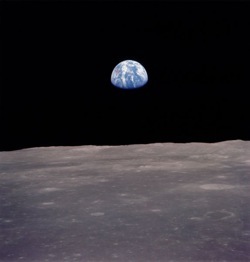



The Earth Never Sets on the Sea of Tranquility
In fact, our planet would be a permanent feature in the sky with the stars, Sun, and the rest of the solar system wheeling behind it rising and setting in a manner similar to what we would expect. The Earth, however, stays fixed in the sky rotating through its twenty-four hour cycle and waxing and waning through monthly phases just like the Moon does when seen from the Earth.
Image courtesy of Wikimedia Commons Project.
More bizarre still - at least it is to me - is that the Moon’s position in the sky is not dependent on the time of the day or the time of the month. It is instead dependent on where you are on the Moon’s surface. With my writer’s cap on I can imagine lunar navigators plying the seas of the Moon using the Earth to steer by much as Earthly navigators use the Pole star. But, with my scientific cap on I have to ask ... “Why is it so?”
Tidal Locking
Tidal locking is an orbital phenomenon that occurs between objects that are gravitationally linked and in a stable relationship. It is commonly seen in moons orbiting planets, with the smaller object being gravitationally locked to the larger, so that it always presents the same face to the planet - just as we see with our Moon. Strangely enough, Pluto, and its moon Charon, are tidally locked to each other such that they both always show the same face to each other.
On Earth, the planet’s rotation is fast enough so that the Moon appears to move through our sky as the planet rotates through its daily cycle. However, shortly after the much smaller Moon was formed, and when it was more pliable than it is now, the Moon’s rotation was forcibly slowed by the gravitational influence of the Earth so that it became the same as its orbital period. This means that although the Moon still rotates on it axis as it travels through space it does not appear to do so for us because its orbit takes it around us in the same amount of time.
A good way of thinking of this is by imagining the Moon spinning around the Earth on the end of a string. The tension of the string keeps the same side of the Moon closest to the Earth and for someone at the attachment point of the string on the Moon the Earth is always permanently overhead.
Observation tells us that many major moons in the solar system are tidally locked to their planets, so it appears to be a common gravitational phenomenon and one that I think could provide some good grist for the mill of a writer somewhere ... Maybe the man in the Moon, perhaps.
References:
For a look at this topic in greater details see the following Wikipedia reference
http://en.wikipedia.org/wiki/Tidal_locking
N.B. Please note that I although I use the Wikipedia (and WikiMedia Commons) a lot for references, this is for expediency and the familiarity of my readers. Anyone interested in further studies should make use of the references where available and understand the Wikipedia is a co-operative project contributable to by anyone and must always be looked at in that light.
Phill Berrie, July, 2008.



